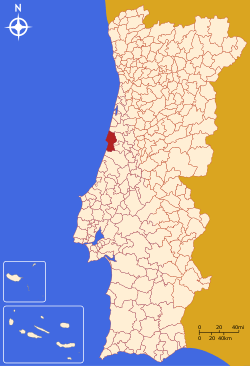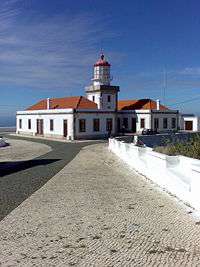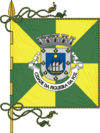Figueira da Foz
| Figueira da Foz | |||
|---|---|---|---|
| Municipality | |||
|
| |||
| |||
 | |||
| Coordinates: 40°09′N 8°51′W / 40.150°N 8.850°WCoordinates: 40°09′N 8°51′W / 40.150°N 8.850°W | |||
| Country |
| ||
| Region | Centro | ||
| Subregion | Baixo Mondego | ||
| Intermunic. comm. | Região de Coimbra | ||
| District | Coimbra | ||
| Parishes | 14 | ||
| Government | |||
| • President | João Ataíde das Neves (PS) | ||
| Area | |||
| • Total | 379.05 km2 (146.35 sq mi) | ||
| Population (2011) | |||
| • Total | 62,125 | ||
| • Density | 160/km2 (420/sq mi) | ||
| Time zone | WET/WEST (UTC+0/+1) | ||
| Website | http://www.cm-figfoz.pt/ | ||
Figueira da Foz (Portuguese pronunciation: [fiˈɣɐjɾɐ ðɐ ˈfɔʃ]), also known as Figueira for short, is a city and a municipality in the Coimbra District, in Portugal. It is located at the mouth of the Mondego River, 40 km west of Coimbra, and sheltered by hills (Serra da Boa Viagem). The population in 2011 was 62,125,[1] in an area of 379.05 km².[2] The city of Figueira da Foz proper has a population of 46,600. It is the second largest city in the district of Coimbra.
It is a coastal city with several beaches, summer and seaport facilities on the Atlantic Ocean coast. As a tourism city, it plays an important part in the centre of the country. A zone of legal gambling, one can find in Figueira one of the biggest casinos of the Iberian Peninsula – the Casino Figueira.
History and landmarks
According to the legend the place’s name is due to a fig tree, which stood at the quay of Salmanha, where the fishermen used to tie up their boats. The historian Nelson Borges said, however, that Figueira comes from the word "fagaria", which means "opening, huge mouth". Foz comes from the Latin word "fouces" = "mouth of a river", and Mondego comes from the pre-romanic expressions "mond" = "mouth" and "aec"= "river". That means, Figueira da Foz would be "the river’s mouth opening". Some historical traces show that people were settling in this region since the Neolithic age. The oldest known document, however, dates from the year 1096. In this an abbot named Pedro donates estates, which belonged to the church of S. Julião, to the cathedral Sé Velha of Coimbra.
Knowing the great importance rivers had in the development of cities and of ancient civilizations, the mouth of the Mondego must have played a central role for the fixation of men in this region and for the formation of settlements, which were the beginning of the city of Figueira da Foz. Figueira da Foz had a huge development during the 18th and 19th centuries due to the immense port movements and the expansion of the shipbuilding and cod drying industry,[3] supplying the city with new communication routes, housing and other facilities. It was elevated to vila (small town) on 12 March 1771 and turned city (cidade) on 20 September 1882. Discovered as a sea resort by the end of the 19th century, it gained great reputation in the 1920s and 1930s. The city had the Portuguese nickname of Rainha das Praias (Queen of the Beaches).
The municipality has some noted landmarks like the Sotto Mayor Palace, the old fishing village of Buarcos, the Serra da Boa Viagem – a small forested mountain by the Atlantic Ocean, several beaches, and its large seaside promenade paved with typical Portuguese pavement. Figueira da Foz has several Churches, many of them in the rich Baroque style, a Municipal Museum with archaeological, ethnographic and artistic collection, the Santa Catarina Fort and the old Buarcos Fortress, the Relógio Tower by the main sandy beachy, several archaeological vestiges throughout the municipality, several Palaces and Manor Houses (like the Sotto Mayor Palace), as well as several green spaces and small gardens like those in the area of Abadias.
Economy
The city is an important industrial centre, producing wood pulp and paper (Soporcel – a Portucel Soporcel company; CELBI – an Altri company) and glass (Saint-Gobain Mondego – a Saint-Gobain company). It also has notable naval construction and fish industries, as well as a factory of the CIMPOR Group installed in the Mondego Cape (Cabo Mondego). The seaport and the fishing harbour are also important for its economy.
With its old and renowned casino (Casino da Figueira), the marina, several hotels, restaurants and other tourist facilities, Figueira is actually a very important Atlantic beach resort, in the center of Portugal's Silver Coast/Costa de Prata tourism region.
Education
The city has well-equipped kindergartens, schools and high schools. It had two private universities: the Catholic University of Portugal (Figueira da Foz branch) and the Internacional University[4] (Figueira da Foz branch) but they were closed in 2009 due to lack of funds and academic integrity.
Parishes
.jpg)
Administratively, the municipality is divided into 14 civil parishes (freguesias):[5]
Demographics
| Population of Figueira da Foz Municipality (1801–2011) | |||||||||
|---|---|---|---|---|---|---|---|---|---|
| 1801 | 1849 | 1900 | 1930 | 1960 | 1981 | 1991 | 2001 | 2008 | 2011 |
| 10 281 | 8 021 | 43 032 | 49 590 | 57 631 | 58 559 | 61 555 | 62 601 | 63 135 | 62 125 |
Climate
Figueira da Foz has a Mediterranean climate (Köppen climate classification Csb) characterized by mild, rainy winters and dry, warm summers. The annual average temperature is around 15 °C (59 °F) and the annual average rainfall is about 600 mm (24 in). The sea surface temperature varies from 14–15 °C (57–59 °F) in January and February to 18–19 °C (64–66 °F) in the August and September. In the summer afternoons moderate to (occasionally) strong north-westerly winds are common.
| Climate data for Figueira da Foz | |||||||||||||
|---|---|---|---|---|---|---|---|---|---|---|---|---|---|
| Month | Jan | Feb | Mar | Apr | May | Jun | Jul | Aug | Sep | Oct | Nov | Dec | Year |
| Record high °C (°F) | 22.0 (71.6) |
24.0 (75.2) |
26.5 (79.7) |
30.0 (86) |
32.6 (90.7) |
37.0 (98.6) |
39.5 (103.1) |
36.4 (97.5) |
33.0 (91.4) |
36.0 (96.8) |
29.2 (84.6) |
23.2 (73.8) |
39.5 (103.1) |
| Average high °C (°F) | 13.6 (56.5) |
14.0 (57.2) |
16.6 (61.9) |
18.4 (65.1) |
19.0 (66.2) |
21.4 (70.5) |
22.5 (72.5) |
22.9 (73.2) |
22.4 (72.3) |
20.1 (68.2) |
17.0 (62.6) |
14.4 (57.9) |
18.5 (65.3) |
| Daily mean °C (°F) | 10.1 (50.2) |
10.5 (50.9) |
13.1 (55.6) |
14.7 (58.5) |
15.8 (60.4) |
18.0 (64.4) |
19.0 (66.2) |
19.2 (66.6) |
18.7 (65.7) |
16.4 (61.5) |
13.6 (56.5) |
11.1 (52) |
15.0 (59) |
| Average low °C (°F) | 6.6 (43.9) |
7.0 (44.6) |
9.6 (49.3) |
11.0 (51.8) |
12.7 (54.9) |
14.7 (58.5) |
15.4 (59.7) |
15.4 (59.7) |
15.0 (59) |
12.8 (55) |
10.2 (50.4) |
7.8 (46) |
11.5 (52.7) |
| Record low °C (°F) | −0.1 (31.8) |
−3.0 (26.6) |
0.4 (32.7) |
0.8 (33.4) |
7.0 (44.6) |
10.2 (50.4) |
7.0 (44.6) |
5.0 (41) |
4.0 (39.2) |
2.0 (35.6) |
2.0 (35.6) |
0.0 (32) |
−3.0 (26.6) |
| Average precipitation mm (inches) | 93.3 (3.673) |
61.3 (2.413) |
84.3 (3.319) |
47.1 (1.854) |
44.4 (1.748) |
16.9 (0.665) |
5.4 (0.213) |
9.0 (0.354) |
29.4 (1.157) |
66.7 (2.626) |
81.0 (3.189) |
88.5 (3.484) |
627.1 (24.689) |
| Average precipitation days | 12 | 11 | 8 | 11 | 7 | 7 | 3 | 1 | 4 | 8 | 10 | 11 | 83 |
| Source: INMG, 1931-1960 Climatology [6] | |||||||||||||
Beaches of Figueira da Foz
- Praia da Figueira da Foz – Relógio – Praia da Bola de Nivea (Europe's widest urban beach)
- Praia da Gala – Figueira da Foz (Cova Gala)
- Praia da Murtinheira – Figueira da Foz
- Praia do Cabo Mondego – Figueira da Foz
- Praia da Leirosa – Figueira da Foz
- Praia da Costa de Lavos – Figueira da Foz
- Praia da Orbitur – Figueira da Foz
- Praia da Cova – Cova Gala (Figueira da Foz)
- Praia do Cabedelo – Figueira da Foz (Cova Gala)
- Praia da Claridade – Figueira da Foz
- Praia de Buarcos – Tamargueira (Figueira da Foz) e Plataforma (Figueira da Foz)
- Praia do Vale do Emide – Figueira da Foz
- Praia de Quiaios – Figueira da Foz (Quiaios)
Gallery
.jpg) Hotels in Figueira
Hotels in Figueira Beach in Quiaios
Beach in Quiaios- Figueira da Foz Bus Station
 Torre do Relógio, Figueira da Foz
Torre do Relógio, Figueira da Foz Castelo das Conchas
Castelo das Conchas- Beach off the city
 Farol do Mondego Lighthouse
Farol do Mondego Lighthouse Figueira da Foz Arts Centre
Figueira da Foz Arts Centre
Sports
Figueira da Foz is home to Associação Naval 1º Maio, best known for its football team of the main Portuguese football league. The city is also home for the basketball department of Ginásio Clube Figueirense which competes in the Portuguese basketball league, adding rowing and swimming to their more notorious activities.[7]
The Tennis Club da Figueira da Foz was founded 1917 and is still located next to the Santa Catarina Fort at the mouth of the Mondego River today.
The city hosted the Mundialto international beachsoccer tournament from 1997 to 2004.
International surf competitions frequently take place in Figueira like the World Surf Championship 2010[8] or the IFCA Slaloms Worlds 2008[9]
International Relations
Figueira da Foz is twinned with:
Notable people
- João César Monteiro, film director, actor, writer and film critic
- João Mário Grilo, film director
- Ticha Penicheiro, WNBA player
- Rui Cordeiro, rugby union footballer
- Luís Wittnich Carrisso, botanist, Professor of the University of Coimbra
- António Santos Rocha, archaeologist
- Madalena Perdigão, musicologist
- Manuel Fernandes Tomás, politician (19th century)
- Hugo Almeida, footballer for Portugal.
- Suzy (singer), Singer and representant of Portugal in Eurovision Song Contest 2014
See also
References
- ↑ "Statistics Portugal". Instituto Nacional de Estatística.
- ↑ Direção-Geral do Território
- ↑ SILVA, A. J. M. (2015), The fable of the cod and the promised sea. About portuguese traditions of bacalhau, in BARATA, F. T- and ROCHA, J. M. (eds.), Heritages and Memories from the Sea, Proceedings of the 1st International Conference of the UNESCO Chair in Intangible Heritage and Traditional Know-How: Linking Heritage, 14–16 January 2015. University of Evora, Évora, pp. 130-143. PDF version
- ↑ Grand Union of Portugal. "Portal do Governo de Portugal: MCTES Universidade Internacional". www.portugal.gov.pt.
- ↑ Diário da República. "Law nr. 11-A/2013, pages 552 49-50" (pdf) (in Portuguese). Retrieved 22 July 2014.
- ↑ INMG (1970). Anuário Climatológico de Portugal, Fasc. XIII. Normais Climatológicas do Continente, Açores e Madeira correspondentes a 1931-1960. (2a ed.).
- ↑ http://ginasiofigueirense.com/index_uk.html
- ↑ "Latest News".
- ↑ "DWSV Regatta Calendar (www.dwsv.net)". www.regattakalender.org.
External links
 "Figueira da Foz". Encyclopædia Britannica. 10 (11th ed.). 1911.
"Figueira da Foz". Encyclopædia Britannica. 10 (11th ed.). 1911.- Central Tourist Region
- Figueira's da Foz Municipality
- Photos from Figueira da Foz
- Surf Camp and Surfing Holidays in Figueira da Foz
- Hostel Figueira da Foz
- Surf Camp Figueira da Foz
- Things to do in Figueira da Foz
- Buarcos Surf Report
- Events in Figueira da Foz
- Surf school in Figueira da Foz – Cabedelo

